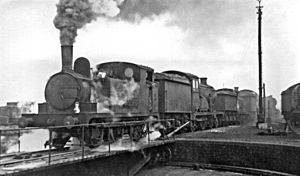GER Class R24 facts for kids
Quick facts for kids GER Class R24LNER Class J67 |
|
 |
|
| On a foggy January Saturday, 18 January 1947, Holden J67 0-6-0T No. 8590 of 1899, is struggling across a turntable with a string of dead locomotives (D15 'Claud' 4-4-0 No. 2509, J15 0-6-0 No. 5374 and D16/3 'Super Claud' 4-4-0 No. 2608). | |
| Power type | Steam |
|---|---|
| Designer | James Holden |
| Builder | Stratford Works |
| Build date | 1890–1901 |
| Total production | 140 |
| Configuration | 0-6-0T |
| UIC classification | C n2t |
| Gauge | 4 ft 8 1⁄2 in (1,435 mm) |
| Driver diameter | 4 ft 0 in (1.219 m) |
| Wheelbase | 13 ft 10 in (4.22 m) |
| Length | 27 ft 8 in (8.43 m) over buffers |
| Locomotive weight | 40 long tons 0 cwt (89,600 lb or 40.6 t) |
| Fuel type | Coal |
| Fuel capacity | 2 long tons 5 cwt (5,000 lb or 2.3 t) |
| Water capacity | 1,000 imp gal (4,550 L; 1,200 US gal) |
| Boiler pressure | 160 psi (1.10 MPa) |
| Fire grate area | 12.4 sq ft (1.15 m2) |
| Heating surface: Total | 987.4 sq ft (91.73 m2) |
| Cylinders | Two, inside |
| Cylinder size | 16+1⁄2 in × 22 in (419 mm × 559 mm) |
| Tractive effort | 16,970 lbf (75.49 kN) |
| Power class | BR: 2F |
| Axle load class | LNER/BR: RA 3 |
| Disposition | 51 rebuilt to R24R, remainder withdrawn 1937–1961 |
The GER Class R24 was a type of steam train designed by James Holden. These trains were built for the Great Eastern Railway (GER). Later, in 1923, they became part of the London and North Eastern Railway (LNER) and were renamed the J67 class.
Some of these R24 trains were made stronger with a higher boiler pressure. These improved trains were very similar to another class called the Class S56. The LNER called these rebuilt R24s and the S56s the J69 class.
Building and Design
These locomotives were quite similar to the Class T18 trains. They shared many of the same measurements for their main parts. All 140 of these trains were built at the GER's own workshop, called Stratford Works. They were made between the years 1890 and 1901.
Over the years, 89 of these trains were updated between 1904 and 1921. They received stronger boilers that could handle more pressure. They also had bigger tanks for water. Most of them were also fitted with air brakes. These improved trains were used for carrying passengers on local and smaller train lines. The 51 trains that were not updated were mainly used for moving goods trains around and shunting (moving wagons in a yard).
When They Stopped Running
The first R24 train was taken out of service in 1931 because it was damaged in an accident. More trains were removed from service in 1937 and 1939.
In October 1939, during World War II, 13 of the J69 trains were loaned to the War Department. Eight of these had originally been built as Class R24s. They were officially sold to the War Department in October 1940. These trains were then used on special military railways, like the Melbourne and Longmoor Military Railways.
After the war, in 1948, all the remaining trains became part of British Railways. They added 60000 to the front of each train's number. Trains started to be taken out of service again from 1953. By 1962, all of these steam locomotives had been retired and stopped running.

